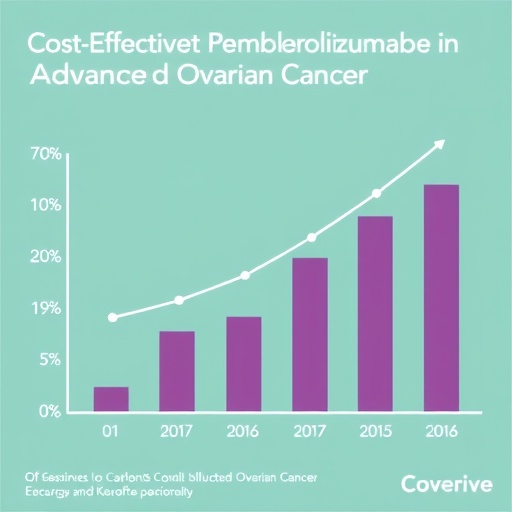In the ongoing battle against ovarian cancer, significant strides are being made towards enhancing treatment protocols aimed at improving patient outcomes. A groundbreaking study conducted by Liu, Zhou, and Zhu, among others, sheds light on the efficacy of a new therapeutic regimen combining pembrolizumab and chemotherapy, followed by maintenance therapy that explores the inclusion or exclusion of olaparib. This innovative approach represents a beacon of hope for patients diagnosed with advanced BRCA wild-type (BRCAwt) ovarian cancer characterized by low levels of loss of heterozygosity (LOH-low).
Ovarian cancer poses a substantial health risk, often diagnosed at advanced stages due to its asymptomatic nature in early development. The search for effective treatment strategies remains critical, as conventional chemotherapy practices deliver limited long-term benefits for many patients. Acknowledging these challenges, this recent study embarks on an exploration of more proactive treatment options that integrate immunotherapy with traditional chemotherapy to potentially elevate patient survival rates.
The integration of pembrolizumab—a programmed death receptor-1 (PD-1) inhibitor—into this treatment regimen is particularly noteworthy. Pembrolizumab functions by unblocking the immune system’s ability to detect and fight cancer cells, thus harnessing the body’s natural defenses in combatting malignancies. Additionally, combining this immunotherapy with chemotherapy aims to create a synergistic effect, promoting a more robust treatment response in patients struggling against the formidable challenges posed by advanced ovarian cancer.
In this study, researchers conducted a meticulous cost-effectiveness analysis to evaluate not just the clinical outcomes, but also the financial implications of implementing this treatment approach on a global scale. Cost-effectiveness analyses are essential as they inform health care providers and policymakers about the economic viability of new treatments, allowing for more informed decisions regarding patient care initiatives.
The findings from this extensive research were illuminating. Among patients with BRCAwt ovarian tumors and LOH-low status, the combination of pembrolizumab and chemotherapy followed by further maintenance therapy with olaparib demonstrated a favorable balance between cost and treatment efficacy. This aspect of the study invites further conversation about the role of personalized medicine and tailoring treatments based on individual patient tumor characteristics, which can potentially enhance therapeutic efficacy while minimizing unnecessary healthcare expenses.
One of the standout elements of the study is its focus on LOH-low tumors, a subgroup that has been less studied in previous research. LOH-low tumors harbor unique genetic profiles that may respond differently to immune checkpoint inhibitors like pembrolizumab. By delving into the details of how these tumors react to such treatments, this research lays the groundwork for future personalized treatment protocols that could significantly alter the standard of care in ovarian cancer treatment.
Further, the study’s authors meticulously accounted for diverse economic factors across nations and healthcare systems—a crucial aspect considering the global burden of ovarian cancer. In particular, their findings could inform healthcare policymakers in various countries about how to allocate resources more effectively to maximize patient benefits and ensure equitable access to breakthrough therapies.
The efficacy of olaparib, a poly (ADP-ribose) polymerase (PARP) inhibitor, in prolonging survival in patients with ovarian cancer has been well documented. By exploring its role as a maintenance therapy in conjunction with immunotherapy and chemotherapy, the researchers aim to redefine treatment paradigms, paving the way for more comprehensive healthcare strategies and improving quality of life for those affected by this disease.
Moreover, the implications of this study extend beyond immediate treatment strategies. As research continues to unpack the landscape of ovarian cancer genetics, findings like those presented by Liu and colleagues could inspire a redesign of clinical trial frameworks, encouraging the exploration of combination therapies tailored to specific genetic markers and tumor characteristics. This, in turn, could enhance patient recruitment strategies and inform subsequent phases of drug development.
The ongoing discourse around the costs of new cancer therapies, particularly in high-stakes scenarios like this, cannot be overstated. As healthcare systems grapple with rising expenditures associated with innovative treatments, understanding the cost-benefit landscape becomes paramount. Researchers in this study emphasize that by demonstrating not only clinical efficacy but also economic feasibility, the combination of pembrolizumab and chemotherapy with olaparib emerges as a compelling option worthy of further investigation.
The study also highlights the critical necessity of multicenter collaboration in clinical research, particularly in the context of global health challenges. By involving diverse populations and healthcare settings in their analysis, the authors present a comprehensive view of how varied demographics might respond to these treatments, ultimately enhancing the robustness of their conclusions.
In conclusion, this research reflects a promising evolution in the treatment of advanced BRCAwt ovarian cancer. The integration of innovative therapies such as immunotherapy alongside established chemotherapeutic agents indicates a shift towards more holistic and effective management approaches. As clinicians, researchers, and patients continue to navigate this complex landscape, the findings underscore the importance of collaborative efforts in the quest for better outcomes in cancer treatment.
This study not only sets the stage for future clinical exploration but also serves as a critical piece of the puzzle in understanding the broader implications of personalized medicine in oncology. The ability to tailor treatments based on genetic specificities could revolutionize not only the management of ovarian cancer but various malignancies, enhancing the promise of precision medicine in the fight against cancer.
Subject of Research: The study investigates the efficacy and cost-effectiveness of pembrolizumab plus chemotherapy followed by maintenance therapy with or without olaparib in advanced BRCAwt ovarian cancer with LOH-low.
Article Title: Pembrolizumab plus chemotherapy followed by maintenance with or without olaparib as first-line treatment for advanced BRCAwt ovarian cancer with LOH-low: an international cost-effectiveness analysis.
Article References:
Liu, K., Zhou, X., Zhu, Y. et al. Pembrolizumab plus chemotherapy followed by maintenance with or without olaparib as first-line treatment for advanced BRCAwt ovarian cancer with LOH-low: a international cost-effectiveness analysis.
J Ovarian Res 18, 244 (2025). https://doi.org/10.1186/s13048-025-01827-8
Image Credits: AI Generated
DOI: https://doi.org/10.1186/s13048-025-01827-8
Keywords: Pembrolizumab, chemotherapy, olaparib, advanced BRCAwt ovarian cancer, LOH-low, cost-effectiveness analysis, personalized medicine, immunotherapy, clinical research.




